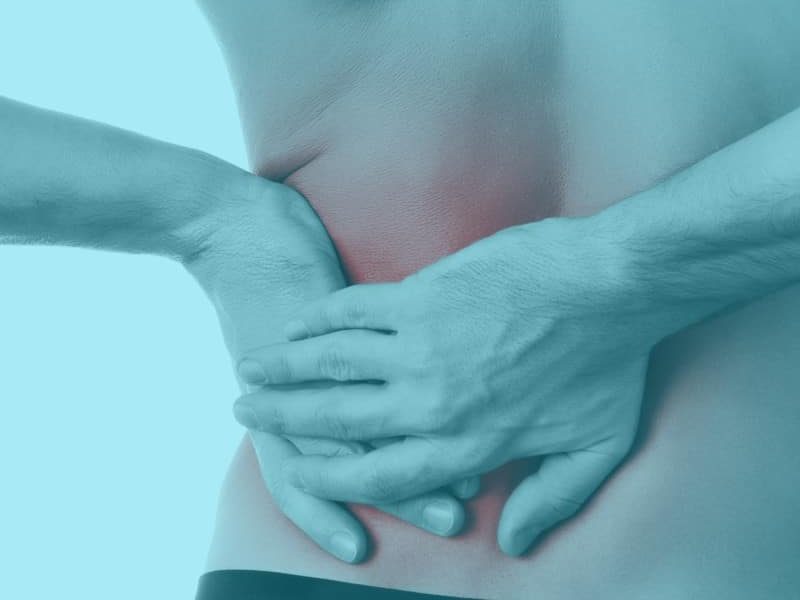If you suffer from ongoing or chronic low back pain, I’m sure many of you reading this will attest to the fact its very difficult finding a professional who can quickly and effectively solve your back pain, with the exercises and stretches often prescribed only achieving short term results. These techniques and tips I have in this article are a great way to treat your own back pain or supplement any treatment you may be getting for better results. I frequently recommend that they embark on a program of self-care or management by which they can treat and release there own muscles using self myofascial release (SMR) techniques. I often use the analogy of brushing your teeth, as you eat and drink throughout the day you need to brush your teeth to prevent damage and decay. Similarly, sitting or standing for long periods throughout the day, high-stress levels, previous injuries, poor posture, heavy or intense training and exercise will cause tension the build up and regular self-treatment is needed to prevent pain.
SMR or Self-trigger point massage has been proven to help people who are suffering from back pain and discomfort by reducing chronic muscle pain and tension tht is either directly or indirectly the cause of the vast majority of back pain patients I see in my chiropractic office. I often recommend these techniques over stretching the muscles, unless the trigger points or knots are released stretching often proves futile. I often describe a tight or tense muscle as an elastic band that has been tied up in a knot. You can stretch and stretch the elastic band, but this does not address the underlying problem likely causing the problem I.e the knot or trigger point. With the techniques listed below you can essentially target and remove this knots on yourself while in the comfort of your own home, they are cheap, effective and safe.
Research has repeatedly found that the presence of knots in the back and hip area can be a source of pain and reduced sleep quality. Patients who wish to manage their condition self-massage of the quadratus lumborum (QL), glute medius/minimus and tensor fascia latae, and erector spinae trigger using a tennis, lacrosse ball or something similar is a great start.
You can massage your trigger points in this way by following three simple steps:
-
Find your trigger points, as describes in the following paragraph and watch the video’s that are linked below.
-
Gently roll a tennis or lacrosse ball over the trigger point and hold for around 30-60 seconds until any tenderness begins to dissipate.
-
Repeat the process for each point coming back to it several times on particularly painful area’s.
You may wish to revisit trigger points that are particularly tight. However, make sure you rest between each massage and apply heat in between. These exercises should never cause you intense or sharp pain.
Erector Spinae and Quadratus Lumborum Muscles. (spine muscles)
These are perhaps the most important muscles when it comes to low back pain. The erector spinae muscle run the full length of the spine and the QL’s run from the hip to the bottom rib. There is a major trigger point where the ribs join the spine, but its best to cover the entire area between the lower ribs and pelvis. These group of muscles when in spasm can cause sever pain, even standing, walking and deep breath’s can be a struggle, I have treated patients who’s pain was so bad from these muscles and their anxiety levels were so high they ended up hospital, often requiring strong pan medication and muscle relaxants. When there is an imbalance in these muscles, left to right it may show up as a scoliosis or in an event of the QL going into spasm on one side the whole spine will be bent to that side with the person unable to straighten.
How to treat the erector spinae and QL
It can be a little difficult to find at first but once do, you will know, as it usually offers a great sense of relief, and a a feeling of “good pain’. Its important to cover from the ribs as described above all the way down to the low back and hips, finishing at the dimples where the spine meets the pelvis. As the low back has a natural curve it in (lordosis) it will need to be flattened to be able to put enough pressure on the msucles, this can be achieved by contracting the abdominals slightly and bend at the knees and bring the heels of your feet to your buttocks, then lean to the side you have the ball on to get even more pressure.
You can watch a video describing how to best treat this muscle-
Tensor Favsa Lattae (TFL), Glute Medius & Minimus (hip muscles)
Problems in these muscles are often felt as hip pain, in can be in both hips as a dull ache just under the belt line, on one side high on the hip or more towards the actual hip joint. These muscles can also refer pain down the the side of the leg, thigh and calf and often confused with sciatca. These muscles are also important for elimating low back pain as compenations and imbalances in these muscles may manifest as low back pain. Its important these muscles are balanced, in order to have a balanced pelvis, for which the spine sits on. When there is acute low back pain often these muscles will cause the hips to shift quite noticebly in order to take pressure of the painful area. People will often complain of pain laying on the hip, generl discomfort when sitting, feeling the need to shift and move around and walk with a limp or slightly altered pattern.
There are 3 main points on either hip, one close to the middle (near spine), middle this is around where the back pockets are located and the side point, which is the part of the hip where the leg jong the pelvis. The middle point you will be laying directly on your back with the ball placed on the fleshy part of the muscle next to the sarcro-illiac joint, the middle you will be laying on a roughly 45-degree angle and the side point, you will be laying on your side with hips hip perpendicular to the floor.
I recommended that you perform these exercises every 1-3 days; however, the ideal treatment frequency will vary from individual to individual. Some people may find that self-massage makes their back problem worse. If you experience this issue, cease treatment. If your muscles are still feeling tender from the self-massage you previously performed, take a longer break. t can be more beneficial to perform self-massage before going to bed as this will give you sufficient time to rest your muscles and allow them to recover before daily use.
A lot of people assume just because they have back pain they must have a weak core, the evidence for this is extremely lacking. There is debate whether there is even such a thing such as a core, yet alone whether strengthening it will have any real benefits. In my experience, most people have the opposite a stiff and immobile spine so walking around constantly bracing your spine will actually make things worse. I generally recommend swimming as it offers full body resistance and very little jarring on the body. Having said that, any regular exercise will help assuming it doesn’t aggravate the problem. Start off light or low intensity and gradually increase this over weeks and months. It’s best to pick something you enjoy as this will make it much easier to adhere to it and it will offer some valuable leisure time.
Heat or cold?
Generally speaking always use heat on back pain, more often than not there is no actual damage or tearing to the area so no inflammation is actually occurring, which is often when ice is prescribed to restrict blood flow. As muscle become tense and tight this restricts blood flow to the area so putting heat will cause the blood vessels to dilate and increase blood flow.



